"This Too Shall Pass" is the title of the song by the band OK Go, but the outpouring of interest that the accompanying music video has generated seems unlikely to pass anytime soon. And that is, to say the least, okay with a group of Caltechers who were involved in the design and construction of the video's eccentric, engaging centerpiece: a two-story-high Rube Goldberg machine whose domino toppling, ball-pinging, balloon-sprouting, flag-waving, umbrella-tumbling antics sweep by in a single surrealistic three-and-a-half-minute take that might have been devised by Dali. A kinder, gentler Dali, who hung out a lot at Disneyland.
On March 1, the charismatic Rube went up on YouTube. Within a day, it had gone viral, attracting a million viewers. Not quite two months later, that number had topped 12 million, a remarkable tally even for OK Go, an L.A.-based indie rock band whose fame rests largely on its canny use of ingenious, self-produced online videos to promote its records.
"People connect to it because it is very original and also very simple," says Oren Schaedel, one of about a dozen Caltech community members from both campus and JPL who had a hand in creating the sprawling, spewing contraption and plotting out its gyrations, from the first falling domino to the final flung paintball. "The underlying principle is that it's based on ideas and uses materials anyone can come up with at home."
A graduate student in biology, Schaedel also coordinated volunteers for the Rube Goldberg project, which was overseen by Syyn Labs, an L.A.-based creative-engineering incubator. After the video was released, he and three of his Caltech colleagues in the biology division—graduate student Megan Dobro; David Koos, a senior research fellow in Caltech's Biological Imaging Center; and Kristy Hilands, the center's research administrator and outreach coordinator—talked about their participation in what Hilands calls "an amazing creative collaboration."
"It was a great experience," says Dobro. "A lot of people from different backgrounds had this wonderful opportunity to get together and use their talents to create something really cool."
They say that a large part of the collaboration originated with MindshareLA, a kind of idea factory that hosts monthly gatherings in downtown Los Angeles, bringing together scientists, artists, entrepreneurs, and others to hear talks and engage in creative brainstorming. Syyn Labs was spun off from Mindshare in 2008, says Schaedel, adding that recruits from the organization, whose motto is "share your brain," played a sizable role in conceiving, designing, and building the nearly four-minute motion machine.
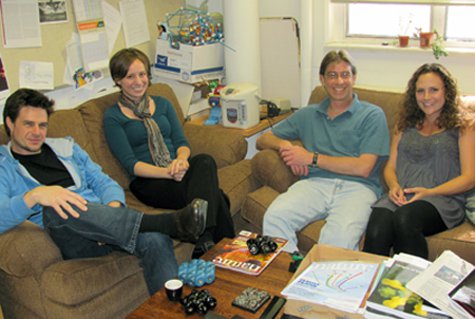
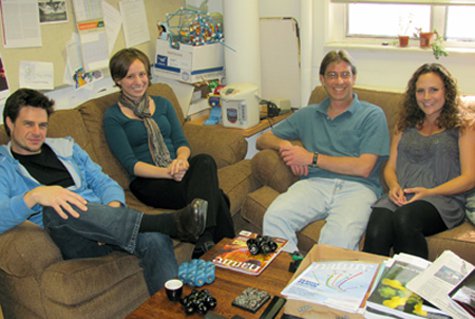
Early reports credited the Rube Goldberg construct to unnamed wonky engineers. But the biologists say it's more accurately described as a gigantic interdisciplinary art and science project. Engineers, scientists of all stripes, graphic designers, media artists, musicians, lighting specialists, animators, carpenters, welders, and even circus riggers got involved.
"We cut a large swath across the creative culture," says Koos of the four-month effort, which at its peak had about 60 people working in shifts virtually around the clock. The project was partially underwritten by State Farm Insurance. Its contribution is acknowledged in the video's opening frame, in which OK Go's Tim Norwind pushes a miniature truck with the "State Farm" logo on its side into a column of dominos, touching off the machine's relentless cascade of activity.
The Rube Goldberg squad did the actual assembly in an abandoned, 10,000-square-foot, two-story warehouse in Echo Park, near downtown Los Angeles. "The entire building had two circuit breakers—one on each floor—and no more than about 40 amps total," says Schaedel, who brought to the project a certain hands-on expertise derived from building bicycles. "It was just enough power for welding and lighting, as long as we didn't try to do both at the same time."
OK Go, which won a Grammy in 2006 for a video that featured the group robot-dancing and clowning around on treadmills, had some definite ideas about how they wanted their latest gonzo offering to look. They wanted the machine strung together from the kind of everyday stuff you might find at a yard sale and to run on mostly mechanical energy. No computers, fancy electronics, or high-tech gimmickry.
The machine had to interact with the four musicians and even perform part of their song—an honor that ultimately went to a pulley-controlled whirling guitar whose neck plinks out part of the tune on water glasses. It had to function flawlessly during a lengthy camera take, like an Olympic figure skater performing a perfect program. It went without saying that the finished product had to be an eye-catching crowd-pleaser.
"At first we tried planning everything out in advance," says Schaedel, but it quickly became clear this approach wasn't going to work. So the participants divided themselves up into four teams, which in turn broke up into numerous smaller groups whose members devised individual components, like plummeting pianos and larger-than-life hydra-headed balloons, and then assembled them into modules. Gradually, everything got fitted together like a giant animated jigsaw
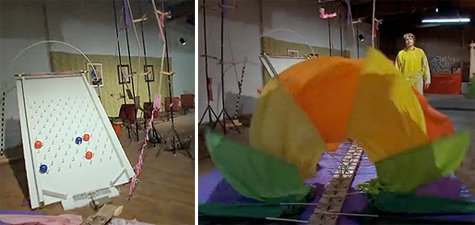
"We ended up trying all kinds of things," says Dobro. "Some worked, some didn't. There was a lot of trial and error, like getting your PhD."
"We were all being very creative but also very empirical," says Hilands. They recognized early on that it made sense to have the lighter, quicker, more finicky modules go into action first and the sturdier components later. That way if the machine malfunctioned during the videotaping, it would most likely be early in the process and they'd waste much less time starting over. They mapped out the mechanics to fit the warehouse, staging the more delicate and unreliable elements of the chain reaction on the top floor and the more robust ones on the bottom. The completed machine, says Koos, operated almost exclusively on mechanical switches and "gravity, gravity, gravity."
"It was," he adds, "quite an education in theory versus application." Application won nearly every time.
Pulling up the "This Too Shall Pass" video on YouTube, the foursome points out some of their contributions. Koos, who put himself through college repairing bridges in Connecticut, had a major hand in the "Plinko ball-fall module," in which balls tumbling down a pegged ramp set off rat-trap triggers that spark a series of flags to pop up from the floor. Hilands, a painter who holds a degree in fine arts from Carnegie Mellon, worked on a particularly magical portion of this sequence, in which the rainbow array of flags unfurls like a Technicolor peacock's tail.
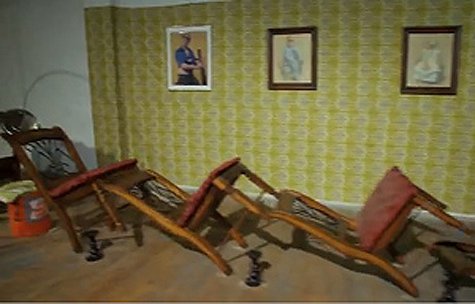
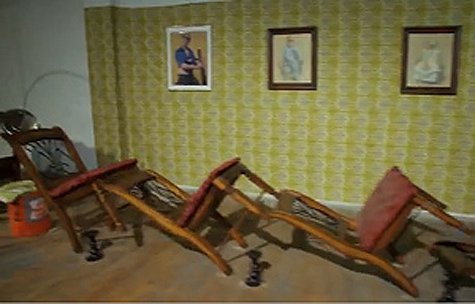
Schaedel oversaw the team that developed and fitted together the "descent" module that transitions the chain reaction from the second floor to the first. Dobro, a craftswoman who also paints and draws, did "lots of drilling" and worked with Hilands on perfecting the flag sequence. But mostly, she says, "I and nearly everyone else worked on a whole variety of things."
When the time came to capture the kinetic contrivance on camera, about 70 takes were needed to get it right. Throughout two days and nights of nearly nonstop filming using a single Steadicam, the device worked flawlessly three times. Of those three takes, one was considered good enough to be posted online. It was an exhilarating and exhausting experience, according to Schaedel, who said in another interview, "We were mainly keeping awake with beer and coffee. I was also cooking some Turkish coffee with cardamom."
After filming finished on February 13, the "build," as everyone had come to call it, was dismantled. Several modules were carted off for display at a special evening event at the Los Angeles County Museum of Art. Those pieces and others are now in storage, but some may be headed for more permanent homes at places like the Hard Rock Café. For now, the machine in all its videotaped glory continues to bask in fame on YouTube.
Although nearly everyone who worked the project had high hopes for its success, its wild popularity caught them somewhat by surprise.
"I don't think a million hits the first day is something any of us expected," says Hilands.
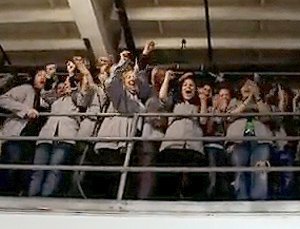
Are Schaedel, Hilands, Dobro, and Koos looking ahead to similar Syyn Lab and Mindshare projects, with or without OK Go? "I know some of us are," says Koos. "I enjoy the camaraderie and having creative outlets that aren't biology."
Says Hilands, "I can't wait 'til next time."
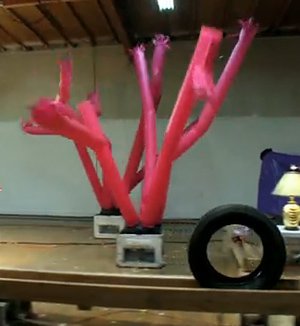 TK TK TK TK TK TK K TKT KTK KK KKTKTKTKTKTKTKTTK TK TK TK TK TK K TKT KTK KK KKTKTKTKTKTKTKT
Credit: OK Go/YouTube
TK TK TK TK TK TK K TKT KTK KK KKTKTKTKTKTKTKTTK TK TK TK TK TK K TKT KTK KK KKTKTKTKTKTKTKT
Credit: OK Go/YouTube
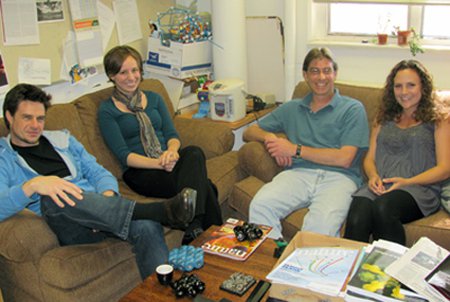 From left, Oren Schaedel, Kristy Hilands, David Koos, and Megan Dubros, all of Caltech's biology division, helped build a Rube Goldberg machine from "materials you can find around the house," or in the average campus lounge.
Credit: Heidi Aspaturian
From left, Oren Schaedel, Kristy Hilands, David Koos, and Megan Dubros, all of Caltech's biology division, helped build a Rube Goldberg machine from "materials you can find around the house," or in the average campus lounge.
Credit: Heidi Aspaturian
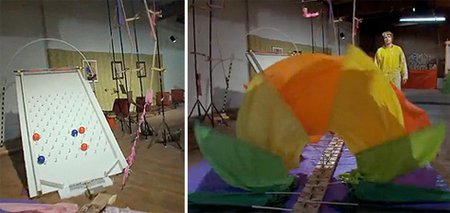 A Plinko table whose ratcheting balls ignite colorful flags via rap-trap triggers owes much to the inventive handiwork of Caltech's David Koos and Kristy Hilands. That OK Go's lead singer Damian Kulash lip-synching the song to the action.
Credit: OK Go/YouTube
A Plinko table whose ratcheting balls ignite colorful flags via rap-trap triggers owes much to the inventive handiwork of Caltech's David Koos and Kristy Hilands. That OK Go's lead singer Damian Kulash lip-synching the song to the action.
Credit: OK Go/YouTube
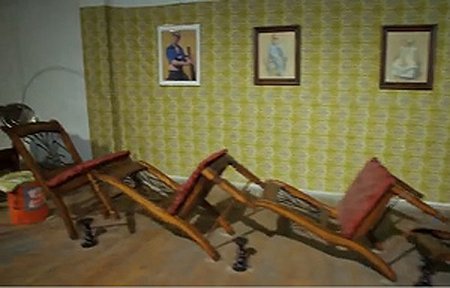 Caltech grad student in biology Megan Dubro found the antique chairs seen here toppling domino fashion; her biology colleague Kristy Hilands brought in the paintings that hang on the wall.
Credit: OK go/YouTube
Caltech grad student in biology Megan Dubro found the antique chairs seen here toppling domino fashion; her biology colleague Kristy Hilands brought in the paintings that hang on the wall.
Credit: OK go/YouTube
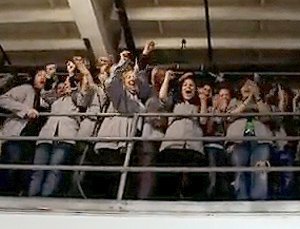 A cross-section of the minds behind the machine applaud their handiwork at the end of the video.
Credit: OK Go/YouTube
A cross-section of the minds behind the machine applaud their handiwork at the end of the video.
Credit: OK Go/YouTube
